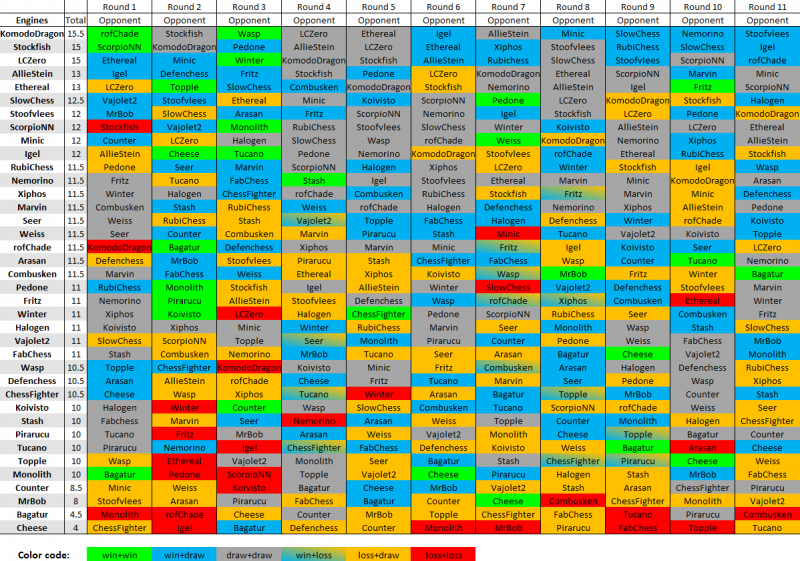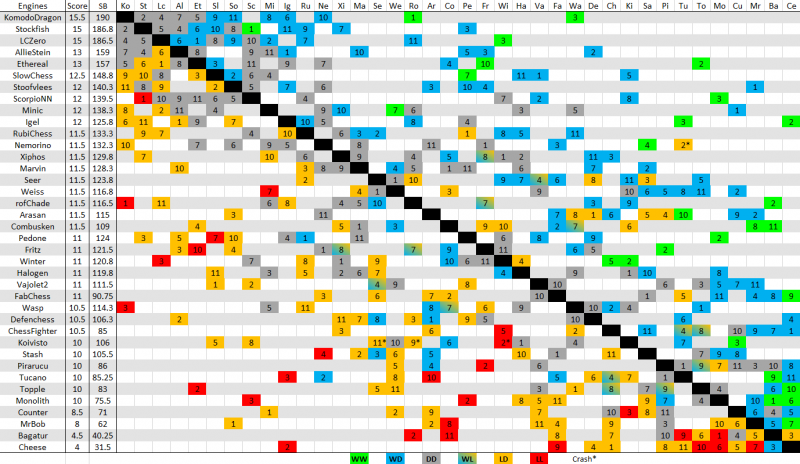TCEC Swiss 1
See also TCEC Swiss rules.
Contents
Tournament format
The TCEC Swiss 1 uses the TCEC Swiss Tournament System (revision 2021-01-16) with the following configuration:
- 11 double rounds
- Group seeding with 40 engines divided in 8 groups. Groups populated using TCEC S20 final standings and two additional engines. A0lite has withdrawn from Swiss.
Invited engines
Almost all engines invited have already filled in the TCEC Questionnaire earlier this season. Only new participants will be asked to do so still.
Here is the full list of engines that are invited and envisioned to participate.
Explanation of special typography:
- underlined means possible invite
- italics - invited for this particular event
- bold - contact has been sought or established with, the author(s)
- bold italics - engine and/or update received.
struck through- declined or not participating
- Stockfish -> update announced
- LCZero -> responded but unclear if updates - update submitted
- KomodoDragon -> update announced -> update to KomodoDragon 2679.08 submitted
- AllieStein - reminder sent -> update to PS 1.5 submitted
- Stoofvlees - reminder sent -> no update, version a18 underway but not ready for this event
- ScorpioNN -> update announced (now with NN + NNUE) - update to 3.0.12 submitted
- Ethereal-> no update
- rofChade - reminder sent -> working on NNUE but update not yet ready for this event
- Igel -> update announced -> update to Igel to 3.0-dev-7 submitted
- SlowChess -> possible update but if not then 2.5 will play - reminder sent - no update
- RubiChess -> might get update - reminder sent
- Xiphos - reminder sent - no update
- Nemorino -> no update
- Defenchess -> no update
- Vajolet2 - reminder sent -> no update, NNUE version underway but not ready for this event
- Pedone -> updated to 20210310
- Winter -> not updated
- Fritz -> might get update - no update
- Arasan -> likely no update -> Arasan v22.2.0-7-gf901010 sent in
- Seer -> update submitted
- Minic -> no update
- Wasp -> update announced -> version Wasp456-linux-modern submitted -> update to final 4.56 submitted
- Tucano -> update announced -> update to version 9.09dev submitted
- Combusken -> development recently stopped: no more updates
- Weiss -> updated to 1.3-dev-current_date
- Counter -> possible update -> 3.8dev submitted
- Topple -> 0.8.0 sent in again (no update)
- Pirarucu -> no update
- Marvin -> no update
- Monolith - reminder sent - no update
- Halogen -> update processed
- ChessFighter -> update announced - no update submitted -> ChessFighterUCI_linux_3_8.exe submitted
- FabChess - reminder sent -> update submitted
- MrBob -> update announced - and received
- Bagatur -> updated to 2.2a
- Koivisto-> updated to 4.29
- Cheese -> no update
- Stash - reminder sent -> update submitted
-
Arminius- unclear, reminder sent - engine not yet ready -
Critter- no email contact established yet, engine not entered
Seeding groups
Group A
- Stockfish
- LCZero
- KomodoDragon
- AllieStein
- Stoofvlees
Group B
- ScorpioNN
- Ethereal
- rofChade
- Igel
- SlowChess
Group C
- RubiChess
- Xiphos
- Nemorino
- Defenchess
- Vajolet2
Group D
- Pedone
- Winter
- Fritz
- Arasan
- Seer
Group E
- Minic
- Wasp
- Tucano
- Combusken
- Weiss
Group F
- Counter
- Topple
- Pirarucu
- Marvin
- Monolith
Group G
- Halogen
- ChessFighter
- FabChess
- MrBob
- Bagatur
Group H
- Koivisto
- Cheese
- Stash
- Arminius
- Critter
Seeding order
- A1 Stockfish
- B1 ScorpioNN
- C1 RubiChess
- D1 Pedone
- E1 Minic
- F1 Counter
- G1 Halogen
- H1 Koivisto
- A2 LCZero
- B2 Ethereal
- C2 Xiphos
- D2 Winter
- ...

